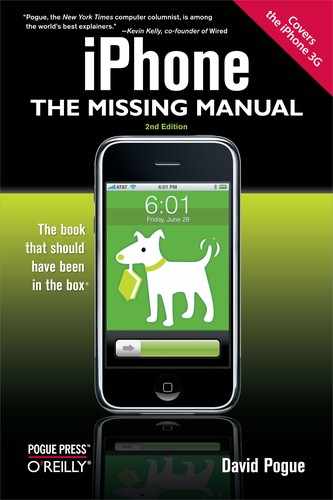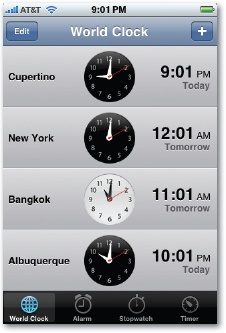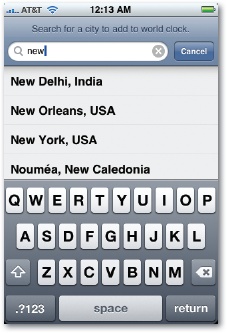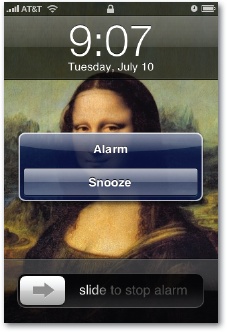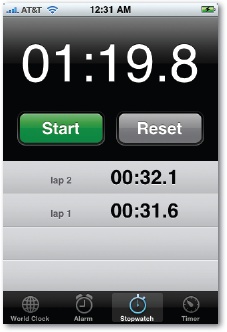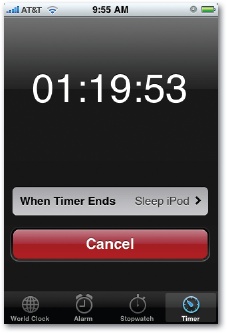It's not just a clock—it's more like a time factory. Hiding behind this single icon on the Home screen are four programs: a world clock, an alarm clock, a stopwatch, and a countdown timer.
When you tap World Clock on the Clock screen, you start out with only one clock, showing the current time in Apple's own Cupertino, California.
Sure, this clock shows the current time, but your phone's status bar does that. The neat part is that you can open up several of these clocks, and set each one up to show the time in a different city. The result looks like the row of clocks in a hotel lobby, making you look Swiss and precise.
By checking these clocks, you'll know what time it is in some remote city, so you don't wind up waking somebody up at what turns out to be three in the morning.
To specify which city's time appears on the clock, tap the ![]() button at the upper-right corner. The keyboard pops up so you can type the name of a major city. As you type, a scrolling list of matching city names appears above the keyboard; tap the one whose time you want to track.
button at the upper-right corner. The keyboard pops up so you can type the name of a major city. As you type, a scrolling list of matching city names appears above the keyboard; tap the one whose time you want to track.
As soon as you tap a city name, you return to the World Clock display. The color of the clock indicates whether it's daytime (white) or night (black). Note, too, that you can scroll the list of clocks. You're not limited to four, although only four fit the screen at once.
Note
Only the world's major cities are in the iPhone's database. If you're trying to track the time in Squirrel Cheeks, New Mexico, consider adding instead a major city in the same time zone—like Albuquerque.
To edit the list of clocks, tap Edit. Now you can delete a city clock by tapping ![]() and then Delete, or drag clocks up or down in the list using the
and then Delete, or drag clocks up or down in the list using the ![]() grip strip as a handle. Then tap Done.
grip strip as a handle. Then tap Done.
If you travel much, this feature could turn out to be one of your iPhone's most useful functions. It's reliable, it's programmable, and it even wakes up the phone first, if necessary, to wake you.
To set an alarm, tap Alarm at the bottom of the Clock program's screen. Tap the ![]() button at the upper-right corner to open the Add Alarm screen.
button at the upper-right corner to open the Add Alarm screen.
Your options here are:
Repeat. Tap to specify what days this alarm rings. You can specify, for example, Mondays, Wednesdays, and Fridays by tapping those three buttons. (Tap a day-of-week button again to turn off its checkmark.) Tap Back when you're done.
Sound. Here's where you specify what sound you want to ring when the time comes. You can choose from any of the iPhone's 25 ringtone sounds. Tap Back.
Snooze. If this option is on, then at the appointed time, the alarm message on the screen offers you a Snooze button. Tap it for 10 more minutes of blissful sleep, at which point the iPhone tries again to get your attention.
Label. Tap to give this alarm a description, like "Get dressed for wedding." That message appears on the screen when the alarm goes off.
Time dials. Spin these three vertical wheels—hour, minute, AM/PM—to specify the time you want the alarm to go off.
When you finally tap Save, you return to the Alarm screen, which lists your new alarm. Just tap the On/Off switch to cancel an alarm. It stays in the list, though, so you can quickly reactivate it another day, without having to redo the whole thing. You can tap the ![]() button to set another alarm, if you like.
button to set another alarm, if you like.
Note, too that the ![]() icon appears in the status bar at the top of the iPhone screen. That's your indicator that the alarm is set.
icon appears in the status bar at the top of the iPhone screen. That's your indicator that the alarm is set.
To delete or edit an alarm, tap Edit. Tap ![]() and then Delete to get rid of an alarm completely, or tap the alarm's name to return to the setup screen, where you can make changes to the time, name, sound, and so on.
and then Delete to get rid of an alarm completely, or tap the alarm's name to return to the setup screen, where you can make changes to the time, name, sound, and so on.
So what happens when the alarm goes off? The iPhone wakes itself up, if it was asleep. A message appears on the screen, identifying the alarm and the time.
And, of course, the sound rings. This alarm is the one and only iPhone sound that you'll hear even if the silencer switch is turned on. Apple figures that if you've gone to the trouble of setting an alarm, you probably really want to know about it, even if you forgot to turn the ringer back on.
In that case, the screen says, "slide to stop alarm."
To cut the ringing short, tap OK or Snooze. After the alarm plays (or you cut it short), its On/Off switch goes to Off (on the Alarms screen).
Tip
With some planning, you can also give yourself a silent, vibrating alarm. It can be a subtle cue that it's time to wrap up your speech, conclude a meeting, or end a date so you can get home to watch Lost.
You have to set this up right, though. If you just turn on the iPhone's silencer switch (Silencer Switch, Volume Keys), then the phone won't ring or vibrate. If you choose None as the alarm sound, it won't ring or vibrate, either. And, of course, you have to make sure the Vibrate mode is turned on in Settings→Sounds.
Here's the trick, then: Do choose an alarm sound. And don't turn off your ringer. Instead, use the volume keys to crank the iPhone's volume all the way to zero. Now, the phone vibrates at the appointed time—but it won't make a sound.
You've never met a more beautiful stopwatch than this one.
Tap Start to begin timing something: a runner, a public speaker, a train, a long-winded person who's arguing with you.
While the digits are flying by, you can tap Lap as often as you like. Each time, the list in the bottom part of the screen identifies how much time had elapsed at the moment you hit Lap. It's a way for you to compare, for example, how much time a runner is spending on each lap around a track.
Note
On most stopwatches, of course, the grand total time keeps ticking away in the main display. The fact that the iPhone's main counter resets to zero each time you tap Lap is a bug, still present in the 2.0 software.
You can do other things on the iPhone while the stopwatch is counting, by the way. In fact, the timer keeps ticking away even when the iPhone is asleep! As a result, you can time long-term events, like how long it takes an ice sculpture to melt, the time it takes for a bean seed to sprout, or the length of a Michael Bay movie.
Tap Stop to freeze the counter; tap Start to resume the timing. If you tap Reset, you reset the counter to zero and erase all the lap times.
The fourth Clock mini-app is a countdown timer. You input a starting time, and it counts down to zero.
Countdown timers are everywhere in life. They measure the time of periods in sports and games, of cooking times in the kitchen, of stunts on Survivor. But on the iPhone, the timer has a especially handy function: It can turn off the music or video after a specified amount of time. In short, it's a Sleep timer that plays you to sleep, then shuts off to save power.
To set the timer, open the Clock app, and then tap Timer. Spin the two dials to specify the number of hours and minutes you want to count down.
Then tap the When Timer Ends control to set up what happens when the timer reaches 0:00. Most of the options here are ringtone sounds, so you'll have an audible cue that the time's up. The top one, though, Sleep iPod, is the aforementioned Sleep timer. It stops audio and video playback at the appointed time, so that you (and the iPhone) can go to sleep. Tap Set.
Finally, tap Start. Big clock digits count down toward zero. While it's in progress, you can do other things on the iPhone, change the When Timer Ends settings, or just hit Cancel to forget the whole thing.
